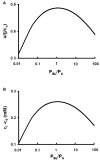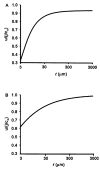Local osmosis and isotonic transport
- PMID: 16596445
- PMCID: PMC1752196
- DOI: 10.1007/s00232-005-0817-9
Local osmosis and isotonic transport
Abstract
Osmotically driven water flow, u (cm/s), between two solutions of identical osmolarity, c(o) (300 mM: in mammals), has a theoretical isotonic maximum given by u = j/c(o), where j (moles/cm(2)/s) is the rate of salt transport. In many experimental studies, transport was found to be indistinguishable from isotonic. The purpose of this work is to investigate the conditions for u to approach isotonic. A necessary condition is that the membrane salt/water permeability ratio, epsilon, must be small: typical physiological values are epsilon = 10(-3) to 10(-5), so epsilon is generally small but this is not sufficient to guarantee near-isotonic transport. If we consider the simplest model of two series membranes, which secrete a tear or drop of sweat (i.e., there are no externally-imposed boundary conditions on the secretion), diffusion is negligible and the predicted osmolarities are: basal = c(o), intracellular approximately (1 + epsilon)c(o), secretion approximately (1 + 2epsilon)c(o), and u approximately (1 - 2epsilon)j/c(o). Note that this model is also appropriate when the transported solution is experimentally collected. Thus, in the absence of external boundary conditions, transport is experimentally indistinguishable from isotonic. However, if external boundary conditions set salt concentrations to c(o) on both sides of the epithelium, then fluid transport depends on distributed osmotic gradients in lateral spaces. If lateral spaces are too short and wide, diffusion dominates convection, reduces osmotic gradients and fluid flow is significantly less than isotonic. Moreover, because apical and basolateral membrane water fluxes are linked by the intracellular osmolarity, water flow is maximum when the total water permeability of basolateral membranes equals that of apical membranes. In the context of the renal proximal tubule, data suggest it is transporting at near optimal conditions. Nevertheless, typical physiological values suggest the newly filtered fluid is reabsorbed at a rate u approximately 0.86 j/c(o), so a hypertonic solution is being reabsorbed. The osmolarity of the filtrate c(F) (M) will therefore diminish with distance from the site of filtration (the glomerulus) until the solution being transported is isotonic with the filtrate, u = j/c(F).With this steady-state condition, the distributed model becomes approximately equivalent to two membranes in series. The osmolarities are now: c(F) approximately (1 - 2epsilon)j/c(o), intracellular approximately (1 - epsilon)c(o), lateral spaces approximately c(o), and u approximately (1 + 2epsilon)j/c(o). The change in c(F) is predicted to occur with a length constant of about 0.3 cm. Thus, membrane transport tends to adjust transmembrane osmotic gradients toward epsilonc(o), which induces water flow that is isotonic to within order epsilon. These findings provide a plausible hypothesis on how the proximal tubule or other epithelia appear to transport an isotonic solution.
Figures







Similar articles
-
Mechanisms of intercellular hypertonicity and isotonic fluid absorption in proximal tubules of mammalian kidneys.Acta Physiol Scand. 2002 May;175(1):71-83. doi: 10.1046/j.1365-201X.2002.00973.x. Acta Physiol Scand. 2002. PMID: 11982506
-
Standing-gradient osmotic flow. A mechanism for coupling of water and solute transport in epithelia.J Gen Physiol. 1967 Sep;50(8):2061-83. doi: 10.1085/jgp.50.8.2061. J Gen Physiol. 1967. PMID: 6066064 Free PMC article.
-
Fluid transport and ion fluxes in mammalian kidney proximal tubule: a model analysis of isotonic transport.Acta Physiol (Oxf). 2006 May-Jun;187(1-2):177-89. doi: 10.1111/j.1748-1716.2006.01580.x. Acta Physiol (Oxf). 2006. PMID: 16734754
-
The lateral intercellular space as osmotic coupling compartment in isotonic transport.Acta Physiol (Oxf). 2009 Jan;195(1):171-86. doi: 10.1111/j.1748-1716.2008.01930.x. Epub 2008 Oct 28. Acta Physiol (Oxf). 2009. PMID: 18983444 Review.
-
Models for coupling of salt and water transport; Proximal tubular reabsorption in Necturus kidney.J Gen Physiol. 1975 Dec;66(6):671-733. doi: 10.1085/jgp.66.6.671. J Gen Physiol. 1975. PMID: 1104761 Free PMC article. Review.
Cited by
-
Multiscale modelling of saliva secretion.Math Biosci. 2014 Nov;257:69-79. doi: 10.1016/j.mbs.2014.06.017. Epub 2014 Jul 8. Math Biosci. 2014. PMID: 25014770 Free PMC article.
-
Frequency spectrum of transepithelial potential difference reveals transport-related oscillations.Biophys J. 2009 Sep 16;97(6):1530-7. doi: 10.1016/j.bpj.2009.05.063. Biophys J. 2009. PMID: 19751657 Free PMC article.
-
A computer model of lens structure and function predicts experimental changes to steady state properties and circulating currents.Biomed Eng Online. 2013 Aug 30;12:85. doi: 10.1186/1475-925X-12-85. Biomed Eng Online. 2013. PMID: 23988187 Free PMC article.
-
Net Fluorescein Flux Across Corneal Endothelium Strongly Suggests Fluid Transport is due to Electro-osmosis.J Membr Biol. 2016 Aug;249(4):469-73. doi: 10.1007/s00232-016-9887-0. Epub 2016 Mar 17. J Membr Biol. 2016. PMID: 26989056 Free PMC article.
-
Modulation of Membrane Trafficking of AQP5 in the Lens in Response to Changes in Zonular Tension Is Mediated by the Mechanosensitive Channel TRPV1.Int J Mol Sci. 2023 May 22;24(10):9080. doi: 10.3390/ijms24109080. Int J Mol Sci. 2023. PMID: 37240426 Free PMC article.
References
Publication types
MeSH terms
Substances
Grants and funding
LinkOut - more resources
Full Text Sources

